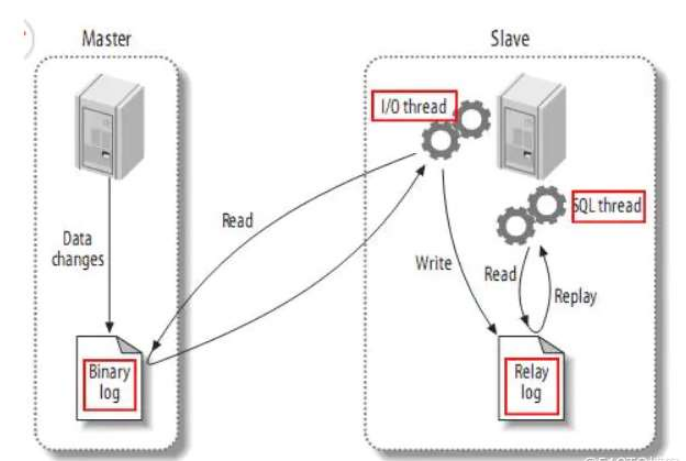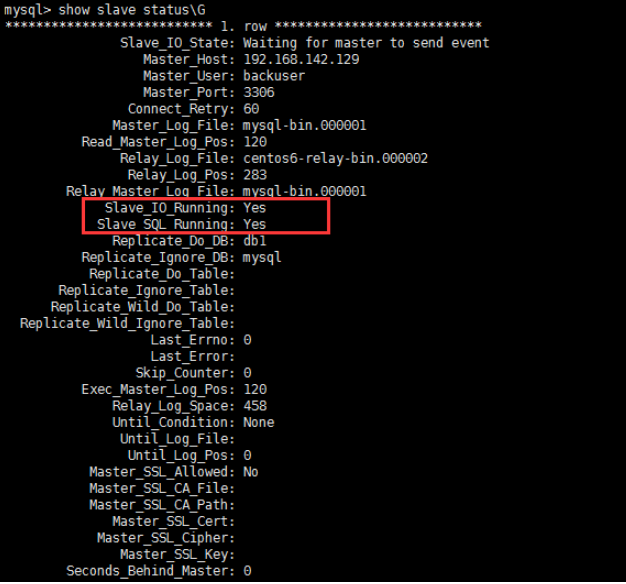本篇内容介绍了“mysql5.6主从搭建的方法是什么”的有关知识,在实际案例的操作过程中,不少人都会遇到这样的困境,接下来就让小编带领大家学习一下如何处理这些情况吧!希望大家仔细阅读,能够学有所成!系统:Centos6.6主:192.168
本篇内容介绍了“mysql5.6主从搭建的方法是什么”的有关知识,在实际案例的操作过程中,不少人都会遇到这样的困境,接下来就让小编带领大家学习一下如何处理这些情况吧!希望大家仔细阅读,能够学有所成!
系统:Centos6.6
主:192.168.142.129 Mysql-5.6.30.tar.gz
从:192.168.142.130 192.168.142.131 mysql-5.6.30.tar.gz

(1) master将改变记录到二进制日志(binary log)中;
(2) slave将master的binary log events拷贝到它的中继日志(relay log);slave的I/O线程从master的二进制日志中读取事件并写入中继日志;
(3) slave重做中继日志中的事件,将改变反映它自己的数据。slave的SQL线程从中继日志读取事件,并在本地重放其中的事件,使其与master中的数据一致。
mysql主从实现的步骤:
1、使用mysqldump 命令备份数据库,
2、查看主节点二进制的位置点
3、创建备份用户,并授权(replication client.replication slave)
4、从服务器修改server-id,必须与主mysql的server-id不同,开启中继日子,关闭二进制日子
5、从数据库,倒入数据,并使用授权用户,连接主mysql
6、start slave
SQL语言共分为以下几大类:查询语言DQL,控制语言DCL,操纵语言DML,定义语言DDL。事务控制TCL.
DQL(Data QUERY Languages)语句:即数据库定义语句,用来查询SELECT子句,FROM子句,WHERE子句组成的查询块,比如:select–from–where–grouop by–having–order by–limit
DDL(Data Definition Languages)语句:即数据库定义语句,用来创建数据库中的表、索引、视图、存储过程、触发器等,常用的语句关键字有CREATE,ALTER,DROP,TRUNCATE,COMMENT,RENAME。增删改表的结构
DML(Data Manipulation Language)语句:即数据操纵语句,用来查询、添加、更新、删除等,常用的语句关键字有:SELECT,INSERT,UPDATE,DELETE,MERGE,CALL,EXPLaiN PLAN,LOCK TABLE,包括通用性的增删改查。增删改表的数据
DCL(Data Control Language)语句:即数据控制语句,用于授权/撤销数据库及其字段的权限(DCL is short name of Data Control Language which includes commands such as GRANT and mostly concerned with rights, permissions and other controls of the database system.)。常用的语句关键字有:GRANT,REVOKE。
TCL(Transaction Control Language)语句:事务控制语句,用于控制事务,常用的语句关键字有:COMMIT,ROLLBACK,SAVEPOINT,SET TRANSACTION。
#!/bin/bashyum -y install make GCc gcc-c++ openssl openssl-devel pcre-devel gd cmake ncurses ncurses-develid -u mysqlif [ `echo $?` -ne 0 ];thengroupadd mysqluseradd -M -g mysql -s /sbin/nologin mysqlfiif [ ! -d "/usr/local/mysql" ];then mkdir -p /usr/local/mysqlfimkdir -p /data/mysqlchown -R mysql:mysql /data/mysqlcd /home/soft/ #软件存放目录tar zxvf mysql-5.6.30.tar.gzcd mysql-5.6.30cmake -DCMAKE_INSTALL_PREFIX=/usr/local/mysql -DSYSCONFDIR=/etc -DMYSQL_DATADIR=/data/mysql/data -DINSTALL_MANDIR=/usr/share/man -DMYSQL_tcp_PORT=3306 -DMYSQL_UNIX_ADDR=/tmp/mysql.sock -DDEFAULT_CHARSET=utf8 -DEXTRA_CHARSETS=all -DDEFAULT_COLLATION=utf8_general_ci -DWITH_READLINE=1 -DWITH_SSL=system -DWITH_EMBEDDED_SERVER=1 -DENABLED_LOCAL_INFILE=1 -DWITH_INNOBASE_STORAGE_ENGINE=1make && make installchown -R mysql:mysql .chmod +x scripts/mysql_install_db./scripts/mysql_install_db --user=mysql --basedir=/usr/local/mysql --datadir=/data/mysqlcp ./support-files/mysql.server /etc/rc.d/init.d/mysqldchmod 755 /etc/init.d/mysqldchkconfig mysqld oncat> /etc/rc.d/init.d/mysqld <<'EOF' #mysql启动脚本#!/bin/sh# Copyright Abandoned 1996 TCX DataKonsult AB & Monty Program KB & Detron HB# This file is public domain and comes with NO WARRANTY of any kind# MySQL daemon start/stop script.# Usually this is put in /etc/init.d (at least on Machines SYSV R4 based# systems) and linked to /etc/rc3.d/S99mysql and /etc/rc0.d/K01mysql.# When this is done the mysql server will be started when the machine is# started and shut down when the systems Goes down.# Comments to support chkconfig on RedHat linux# chkconfig: 2345 64 36# description: A very fast and reliable SQL database engine.# Comments to support LSB init script conventions### BEGIN INIT INFO# Provides: mysql# Required-Start: $local_fs $network $remote_fs# Should-Start: ypbind nscd ldap ntpd xntpd# Required-Stop: $local_fs $network $remote_fs# Default-Start: 2 3 4 5# Default-Stop: 0 1 6# Short-Description: start and stop MySQL# Description: MySQL is a very fast and reliable SQL database engine.### END INIT INFO# If you install MySQL on some other places than /usr/local/mysql, then you# have to do one of the following things for this script to work:## - Run this script from within the MySQL installation directory# - Create a /etc/my.cnf file with the following infORMation:# [mysqld]# basedir=<path-to-mysql-installation-directory># - Add the above to any other configuration file (for example ~/.my.ini)# and copy my_print_defaults to /usr/bin# - Add the path to the mysql-installation-directory to the basedir variable# below.## If you want to affect other MySQL variables, you should make your changes# in the /etc/my.cnf, ~/.my.cnf or other MySQL configuration files.# If you change base dir, you must also change datadir. These may get# overwritten by settings in the MySQL configuration files.basedir=/usr/local/mysqldatadir=/data/mysql# Default value, in seconds, afterwhich the script should timeout waiting# for server start. # Value here is overriden by value in my.cnf. # 0 means don't wait at all# Negative numbers mean to wait indefinitelyservice_startup_timeout=900# Lock directory for RedHat / SuSE.lockdir='/var/lock/subsys'lock_file_path="$lockdir/mysql"# The following variables are only set for letting mysql.server find things.# Set some defaultsmysqld_pid_file_path=if test -z "$basedir"then basedir=/usr/local/mysql bindir=/usr/local/mysql/bin if test -z "$datadir" then datadir=/data/mysql/data fi sbindir=/usr/local/mysql/bin libexecdir=/usr/local/mysql/binelse bindir="$basedir/bin" if test -z "$datadir" then datadir="$basedir/data" fi sbindir="$basedir/sbin" libexecdir="$basedir/libexec"fi# datadir_set is used to determine if datadir was set (and so should be# *not* set inside of the --basedir= handler.)datadir_set=# Use LSB init script functions for printing messages, if possible#lsb_functions="/lib/lsb/init-functions"if test -f $lsb_functions ; then . $lsb_functionselse log_success_msg() { echo " SUCCESS! $@" } log_failure_msg() { echo " ERROR! $@" }fiPATH="/sbin:/usr/sbin:/bin:/usr/bin:$basedir/bin"export PATHmode=$1 # start or stop[ $# -ge 1 ] && shiftother_args="$*" # uncommon, but needed when called from an RPM upgrade action # Expected: "--skip-networking --skip-grant-tables" # They are not checked here, intentionally, as it is the resposibility # of the "spec" file author to give correct arguments only.case `echo "testing\c"`,`echo -n testing` in *c*,-n*) echo_n= echo_c= ;; *c*,*) echo_n=-n echo_c= ;; *) echo_n= echo_c='\c' ;;esacparse_server_arguments() { for arg do case "$arg" in --basedir=*) basedir=`echo "$arg" | sed -e 's/^[^=]*=//'` bindir="$basedir/bin" if test -z "$datadir_set"; then datadir="$basedir/data" fi sbindir="$basedir/sbin" libexecdir="$basedir/libexec" ;; --datadir=*) datadir=`echo "$arg" | sed -e 's/^[^=]*=//'` datadir_set=1 ;; --pid-file=*) mysqld_pid_file_path=`echo "$arg" | sed -e 's/^[^=]*=//'` ;; --service-startup-timeout=*) service_startup_timeout=`echo "$arg" | sed -e 's/^[^=]*=//'` ;; esac done}wait_for_pid () { verb="$1" # created | removed pid="$2" # process ID of the program operating on the pid-filepid_file_path="$3" # path to the PID file. i=0 avoid_race_condition="by checking again" while test $i -ne $service_startup_timeout ; do case "$verb" in 'created') # wait for a PID-file to pop into existence. test -s "$pid_file_path" && i='' && break ;; 'removed') # wait for this PID-file to disappear test ! -s "$pid_file_path" && i='' && break ;; *) echo "wait_for_pid () usage: wait_for_pid created|removed pid pid_file_path" exit 1 ;; esac # if server isn't running, then pid-file will never be updated if test -n "$pid"; then if kill -0 "$pid" 2>/dev/null; then : # the server still runs else # The server may have exited between the last pid-file check and now. if test -n "$avoid_race_condition"; then avoid_race_condition="" continue # Check again. fi # there's nothing that will affect the file. log_failure_msg "The server quit without updating PID file ($pid_file_path)." return 1 # not waiting any more. fi fi echo $echo_n ".$echo_c" i=`expr $i + 1` sleep 1 done if test -z "$i" ; then log_success_msg return 0 else log_failure_msg return 1 fi}# Get arguments from the my.cnf file,# the only group, which is read from now on is [mysqld]if test -x ./bin/my_print_defaultsthen print_defaults="./bin/my_print_defaults"elif test -x $bindir/my_print_defaultsthen print_defaults="$bindir/my_print_defaults"elif test -x $bindir/mysql_print_defaultsthen print_defaults="$bindir/mysql_print_defaults"else # Try to find basedir in /etc/my.cnf conf=/etc/my.cnf print_defaults= if test -r $conf then subpat='^[^=]*basedir[^=]*=\(.*\)$' dirs=`sed -e "/$subpat/!d" -e 's//\1/' $conf` for d in $dirs do d=`echo $d | sed -e 's/[ ]//g'` if test -x "$d/bin/my_print_defaults" then print_defaults="$d/bin/my_print_defaults" break fi if test -x "$d/bin/mysql_print_defaults" then print_defaults="$d/bin/mysql_print_defaults" break fi done fi # Hope it's in the PATH ... but I doubt it test -z "$print_defaults" && print_defaults="my_print_defaults"fi## Read defaults file from 'basedir'. If there is no defaults file there# check if it's in the old (depricated) place (datadir) and read it from there#extra_args=""if test -r "$basedir/my.cnf"then extra_args="-e $basedir/my.cnf"else if test -r "$datadir/my.cnf" then extra_args="-e $datadir/my.cnf" fifiparse_server_arguments `$print_defaults $extra_args mysqld server mysql_server mysql.server`## Set pid file if not given#if test -z "$mysqld_pid_file_path"then mysqld_pid_file_path=$datadir/`hostname`.pidelse case "$mysqld_pid_file_path" in /* ) ;; * ) mysqld_pid_file_path="$datadir/$mysqld_pid_file_path" ;; esacficase "$mode" in 'start') # Start daemon # Safeguard (relative paths, core dumps..) cd $basedir echo $echo_n "Starting MySQL" if test -x $bindir/mysqld_safe then # Give extra arguments to mysqld with the my.cnf file. This script # may be overwritten at next upgrade. $bindir/mysqld_safe --datadir="$datadir" --pid-file="$mysqld_pid_file_path" $other_args >/dev/null 2>&1 & wait_for_pid created "$!" "$mysqld_pid_file_path"; return_value=$? # Make lock for RedHat / SuSE if test -w "$lockdir" then touch "$lock_file_path" fi exit $return_value else log_failure_msg "Couldn't find MySQL server ($bindir/mysqld_safe)" fi ;; 'stop') # Stop daemon. We use a signal here to avoid having to know the # root passWord. if test -s "$mysqld_pid_file_path" then mysqld_pid=`cat "$mysqld_pid_file_path"` if (kill -0 $mysqld_pid 2>/dev/null) then echo $echo_n "Shutting down MySQL" kill $mysqld_pid # mysqld should remove the pid file when it exits, so wait for it. wait_for_pid removed "$mysqld_pid" "$mysqld_pid_file_path"; return_value=$? else log_failure_msg "MySQL server process #$mysqld_pid is not running!" rm "$mysqld_pid_file_path" fi # Delete lock for RedHat / SuSE if test -f "$lock_file_path" then rm -f "$lock_file_path" fi exit $return_value else log_failure_msg "MySQL server PID file could not be found!" fi ;; 'restart') # Stop the service and regardless of whether it was # running or not, start it again. if $0 stop $other_args; then $0 start $other_args else log_failure_msg "Failed to stop running server, so refusing to try to start." exit 1 fi ;; 'reload'|'force-reload') if test -s "$mysqld_pid_file_path" ; then read mysqld_pid < "$mysqld_pid_file_path" kill -HUP $mysqld_pid && log_success_msg "Reloading service MySQL" touch "$mysqld_pid_file_path" else log_failure_msg "MySQL PID file could not be found!" exit 1 fi ;; 'status') # First, check to see if pid file exists if test -s "$mysqld_pid_file_path" ; then read mysqld_pid < "$mysqld_pid_file_path" if kill -0 $mysqld_pid 2>/dev/null ; then log_success_msg "MySQL running ($mysqld_pid)" exit 0 else log_failure_msg "MySQL is not running, but PID file exists" exit 1 fi else # Try to find appropriate mysqld process mysqld_pid=`pidof $libexecdir/mysqld` if test -z $mysqld_pid ; then if test -f "$lock_file_path" ; then log_failure_msg "MySQL is not running, but lock file ($lock_file_path) exists" exit 2 fi log_failure_msg "MySQL is not running" exit 3 else log_failure_msg "MySQL is running but PID file could not be found" exit 4 fi fi ;; *) # usage basename=`basename "$0"` echo "Usage: $basename {start|stop|restart|reload|force-reload|status} [ MySQL server options ]" exit 1 ;; esacexit 0EOFcat> /etc/my.cnf <<'EOF' #mysql配置文件[client]#password = your_passwordport = 3306Socket = /tmp/mysql.sock# Here follows entries for some specific programs# The MySQL server[mysqld]port = 3306socket = /tmp/mysql.sockskip-external-lockingkey_buffer_size = 384Mmax_allowed_packet = 64Mtable_open_cache = 512sort_buffer_size = 2Mread_buffer_size = 2Mread_rnd_buffer_size = 8Mmyisam_sort_buffer_size = 64Mthread_cache_size = 8query_cache_size = 32M# Try number of CPU's*2 for thread_concurrencythread_concurrency = 8basedir = /usr/local/mysqldatadir = /data/mysqlmax_connections = 5000long_query_time = 1slow_query_log = 1slow_query_log_file = /var/log/mysql/slow.log# Don't listen on a TCP/IP port at all. This can be a security enhancement,# if all processes that need to connect to mysqld run on the same host.# All interaction with mysqld must be made via Unix sockets or named pipes.# Note that using this option without enabling named pipes on windows# (via the "enable-named-pipe" option) will render mysqld useless!lower_case_table_names = 1# Replication Master Server (default)# binary logging is required for replication#log-bin=mysql-binskip-name-resolve# required unique id between 1 and 2^32 - 1# defaults to 1 if master-host is not set# but will not function as a master if omitted#server-id = 1# binary logging - not required for slaves, but recommended#log-bin=mysql-bin## binary logging format - mixed recommended #binlog_format=mixed# Uncomment the following if you are using InnoDB tables#innodb_data_home_dir = /data/mysql/data#innodb_data_file_path = ibdata1:2000M;ibdata2:10M:autoextend#innodb_log_group_home_dir = /data/mysql/data# You can set .._buffer_pool_size up to 50 - 80 %# of RAM but beware of setting memory usage too highinnodb_buffer_pool_size = 4096M#innodb_additional_mem_pool_size = 20M# Set .._log_file_size to 25 % of buffer pool sizeinnodb_log_file_size = 512M#innodb_log_buffer_size = 8Minnodb_flush_log_at_trx_commit = 0#innodb_lock_wait_timeout = 50[mysqldump]quickmax_allowed_packet = 64M[mysql]no-auto-rehash# Remove the next comment character if you are not familiar with SQL#safe-updates[myisamchk]key_buffer_size = 256Msort_buffer_size = 256Mread_buffer = 2Mwrite_buffer = 2M[mysqlhotcopy]interactive-timeoutEOFln -s /usr/local/mysql/bin/mysqladmin /usr/binln -s /usr/local/mysql/lib/mysql /usr/libln -s /usr/local/mysql/include/mysql /usr/include/mysqlmkdir /var/lib/mysqlln -s /tmp/mysql.sock /var/lib/mysql/mysql.sockecho 'export PATH=$PATH:/usr/local/mysql/bin' >> /etc/profilesleep 2source /etc/profileservice mysqld startsleep 5cd /usr/local/mysql/bin && mysqladmin -uroot password 'mysql' #授权root用户的passwordsource /etc/profile1、这里验证主库有数据的情况,然后授权有复制权限的用户
mysql> create database db1;mysql> use db1mysql> create table t1(id int, name varchar(12));mysql> insert into t1 values(1, 'tom'), (2, 'jerry'), (3, 'jack');mysql> grant replication slave,replication client on *.* to 'backuser'@'192.168.142.130' identified by 'mysqll';mysql> grant replication slave,replication client on *.* to 'backuser'@'192.168.142.131' identified by 'mysql';mysql> flush privileges;2、修改各个数据库的配置文件后重启数据库
vi /etc/my.cnf #主库配置文件server-id=1log-bin=mysql-binbinlog-do-db=db1binlog-ignore-db=mysql vi /etc/my.cnf #从库配置文件server-id=2 #从库id不能和主库一样,其他从库往后面排log-bin=relay-binreplicate-do-db=db1 #同步db1库replicate-ignore-db=mysql #不会同步mysql库read_only #只读service mysqld restart3、主库锁表备份,然后文件传给从库
mysql> flush tables with read lock; #主库锁表防止新的数据写入mysql> show master status; #查看主库位置节点新打开一个终端备份:mysqldump -u root -p --default-character-set=utf8 --opt -Q -R --skip-lock-tables db1 > /root/db1.sql scp /root/db1.sql root@192.168.142.130:/root scp /root/db1.sql root@192.168.142.130:/root4、从库导入数据,然后change到主库的节点
mysql -u root -pmysql> create database db1;mysql> use db1mysql> source /root/db1.sqlmysql> change master to master_host='192.168.142.129',master_user='backuser',master_password='mysql',master_log_file='mysql-bin.000001',master_log_pos=120;mysql> start slave;mysql> show slave status\G
5、主库解锁
mysql> unlock tables;
以上配置对主从不同步,重新配置主从同样适用。
1、造成不同步的原因
网络的延迟主从两台机器的负载不一致max_allowed_packet设置不一致key自增键开始的键值跟自增步长设置不一致引起的主从不一致mysql异常宕机情况下,如果未设置sync_binlog=1或者innodb_flush_log_at_trx_commit=1很有可能
出现binlog或者relaylog文件出现损坏,导致主从不一致mysql本身的bug引起的主从不同步版本不一致,特别是高版本是主,低版本为从的情况下,主数据库上面支持的功能,从数据库上面不支持该功能
2、解决办法
(1)忽略错误后,继续同步
该方法适用于主从库数据相差不大,或者要求数据可以不完全统一的情况,数据要求不严格的情况
stop slave; set global sql_slave_skip_counter =1; start slave; show slave status\G(2)重新做主从
参考上面配置主库锁表重新做主从。
“mysql5.6主从搭建的方法是什么”的内容就介绍到这里了,感谢大家的阅读。如果想了解更多行业相关的知识可以关注编程网网站,小编将为大家输出更多高质量的实用文章!
--结束END--
本文标题: mysql5.6主从搭建的方法是什么
本文链接: https://www.lsjlt.com/news/301121.html(转载时请注明来源链接)
有问题或投稿请发送至: 邮箱/279061341@qq.com QQ/279061341
下载Word文档到电脑,方便收藏和打印~
2024-05-15
2024-05-15
2024-05-15
2024-05-15
2024-05-15
2024-05-15
2024-05-15
2024-05-15
2024-05-15
2024-05-15
回答
回答
回答
回答
回答
回答
回答
回答
回答
回答
0